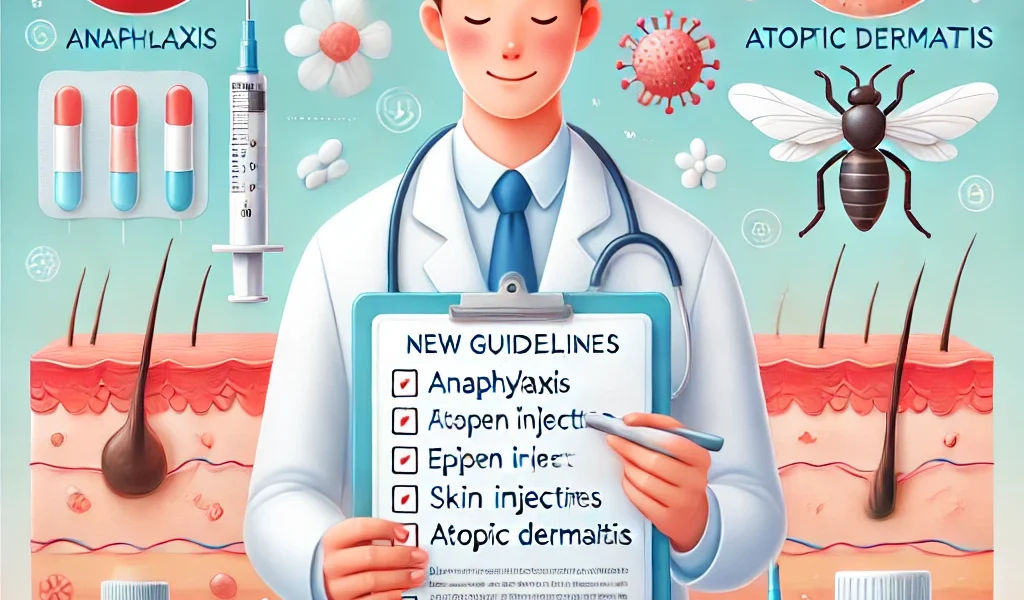New Guidelines for Anaphylaxis and Atopic Dermatitis
Introduction
Both anaphylaxis and atopic dermatitis are significant allergic conditions that can severely affect the quality of life of patients. Anaphylaxis is a life-threatening allergic reaction that requires immediate intervention, while atopic dermatitis (commonly known as eczema) is a chronic skin condition that causes inflammation and itching. Recent updates in medical guidelines have provided healthcare providers with more refined approaches for diagnosing, managing, and treating these conditions. These new guidelines aim to improve patient outcomes and provide a standardized approach to care.
In this article, we will explore the new guidelines for managing anaphylaxis and atopic dermatitis, focusing on key changes and what they mean for healthcare providers and patients.
What is Anaphylaxis?
Anaphylaxis is a severe, potentially life-threatening allergic reaction that can occur rapidly after exposure to an allergen. Common triggers include food, insect stings, medications, and latex. Anaphylaxis affects multiple organ systems, including the skin, respiratory system, gastrointestinal tract, and cardiovascular system. Immediate intervention with epinephrine is critical to prevent fatal outcomes.
Symptoms of Anaphylaxis
Symptoms can occur within minutes of exposure and include:
- Swelling of the lips, tongue, or throat (angioedema)
- Difficulty breathing, wheezing, or shortness of breath
- Hives or a rash
- Abdominal pain, vomiting, or diarrhea
- Dizziness, lightheadedness, or fainting
- Rapid or weak pulse
New Guidelines for Managing Anaphylaxis
Recent updates to the management of anaphylaxis provide clearer protocols for diagnosing and treating the condition in emergency settings. Here are the key changes in the new guidelines:
1. Epinephrine as the First-Line Treatment
The new guidelines emphasize that epinephrine should be administered immediately in cases of suspected anaphylaxis. Delays in epinephrine administration are associated with increased risk of fatal outcomes. Healthcare providers are advised not to wait for more severe symptoms before administering epinephrine.
- Dosage and Administration:
- Intramuscular (IM) injection of epinephrine into the thigh is recommended as the most effective route.
- Adults: 0.3–0.5 mg of epinephrine
- Children: 0.01 mg/kg (with a maximum dose of 0.3 mg)
2. Observation Periods After Epinephrine Administration
Patients who receive epinephrine for anaphylaxis should be monitored for a minimum of 4 to 6 hours due to the risk of a biphasic reaction, where symptoms recur after the initial response has resolved. The new guidelines suggest that patients with severe reactions or those requiring multiple doses of epinephrine may need extended observation.
3. Second-Line Treatments
Second-line treatments, such as antihistamines and corticosteroids, are still recommended to manage the symptoms of anaphylaxis, but they should not delay the administration of epinephrine. The guidelines now make it clear that these medications are adjuncts and do not replace the life-saving effects of epinephrine.
4. Epinephrine Auto-Injectors for At-Risk Patients
Patients with a history of anaphylaxis or those at high risk should always carry an epinephrine auto-injector (such as EpiPen or Auvi-Q). Healthcare providers are encouraged to educate patients and caregivers on the proper use of these devices and ensure they are readily available in schools, workplaces, and homes.
What is Atopic Dermatitis?
Atopic dermatitis (AD), commonly referred to as eczema, is a chronic inflammatory skin condition that affects millions of people worldwide. It is characterized by dry, itchy skin, redness, and sometimes blistering or oozing. The condition is linked to an overactive immune response and is often seen in individuals with a history of allergies, asthma, or hay fever.
Symptoms of Atopic Dermatitis
Common symptoms include:
- Red or brownish patches of dry, scaly skin
- Intense itching, which may worsen at night
- Cracked, thickened, or leathery skin
- Small, raised bumps that may leak fluid or crust over when scratched
- Inflammation, especially around the neck, elbows, knees, and face
New Guidelines for Managing Atopic Dermatitis
The new guidelines for atopic dermatitis provide updates on the treatment options, emphasizing a personalized approach to managing the condition. Key changes include:
1. Personalized Skincare Routine
The guidelines stress the importance of an individualized skincare regimen. This includes regular use of moisturizers to restore the skin’s barrier function and reduce flare-ups. Moisturizers should be applied immediately after bathing to lock in moisture.
- Types of Moisturizers: The guidelines recommend using emollients, humectants, and occlusive agents depending on the patient’s skin type and severity of the condition. Fragrance-free and hypoallergenic products are preferred to avoid irritation.
2. Topical Anti-Inflammatory Treatments
For mild to moderate cases of atopic dermatitis, the use of topical corticosteroids and topical calcineurin inhibitors (TCIs) is recommended. These anti-inflammatory treatments help to reduce redness, itching, and flare-ups.
- Topical corticosteroids: These are the first-line treatment for flare-ups. The potency of the corticosteroid should be matched to the severity of the condition.
- Topical calcineurin inhibitors (TCIs): These non-steroidal creams (such as tacrolimus or pimecrolimus) are used for sensitive areas like the face and in cases where long-term steroid use is not desirable.
3. Dupilumab for Severe Cases
One of the major updates in the guidelines is the recommendation of Dupilumab, a biologic therapy, for patients with moderate to severe atopic dermatitis who do not respond well to topical treatments. Dupilumab is an injectable monoclonal antibody that targets key pathways in the immune system responsible for inflammation.
4. Addressing Comorbidities
Atopic dermatitis is often associated with other allergic conditions, such as asthma and allergic rhinitis. The new guidelines suggest a more holistic approach to treating atopic dermatitis by addressing these comorbidities. For instance, managing underlying allergic triggers (e.g., food allergies or dust mites) can help reduce the frequency and severity of eczema flare-ups.
5. Importance of Patient Education
The guidelines emphasize the importance of educating patients about their condition, including proper skincare, trigger avoidance, and adherence to treatment plans. Providing patients with resources, such as written instructions or online tools, is encouraged to ensure they understand how to manage their condition effectively.
6. Use of Probiotics and Diet
Although the evidence is still evolving, the new guidelines suggest that probiotics may play a role in improving skin health and reducing flare-ups for some patients with atopic dermatitis. Additionally, dietary modifications, particularly in children with food allergies, may also help manage symptoms.
Conclusion
The new guidelines for managing anaphylaxis and atopic dermatitis provide healthcare providers with more structured and updated approaches to improve patient outcomes. For anaphylaxis, the emphasis is on the immediate administration of epinephrine, proper observation, and the education of at-risk individuals on the use of auto-injectors. In the case of atopic dermatitis, a more personalized treatment approach is recommended, incorporating moisturizers, anti-inflammatory treatments, and newer biologic therapies like Dupilumab for severe cases.
By staying informed about these updated guidelines, healthcare providers can offer more effective care, ensuring better long-term management of these allergic conditions and improving the quality of life for patients.




